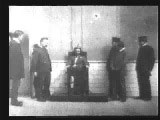The Electric Chair
In 1885, the newly elected governor of New York City, David Hill — horrified by an execution he had witnessed when he was district attorney — resolves to find a more humane way to execute criminals. Up to this point, hanging has been the most common method of carrying out the death penalty. Convinced that science will devise a more civilized and progressive capital punishment, Hill organizes a committee to look into the matter.
What is remarkable about this group is that no clergy are involved; doctors are the primary experts consulted. This marks a significant shift in penology away from the authority of religion and toward scientific resolutions. Another notable trend of this time is the "professionalization" of death. Executions begin to be held in centralized locations and conducted by state executioners.
At the time, electricity is being used by some people as a healing agent and by others as a way to exterminate unwanted animals. So inventor Thomas Edison is enlisted to help create the electric chair. The first electrocution takes place at Auburn in New York in 1890. A doctor gives the signal, the switch is thrown, and the prisoner, William Kemmler, is quite literally fried. The press reports it as a disaster. With further experimentation, it is discovered how much voltage is needed to kill a human being. The first woman to die in the chair, Mrs. Martha Place, is executed in 1899.
 |
| Electrocution of Czolgosz at Auburn Prison Thomas A. Edison, Inc., 1901. Library of Congress |